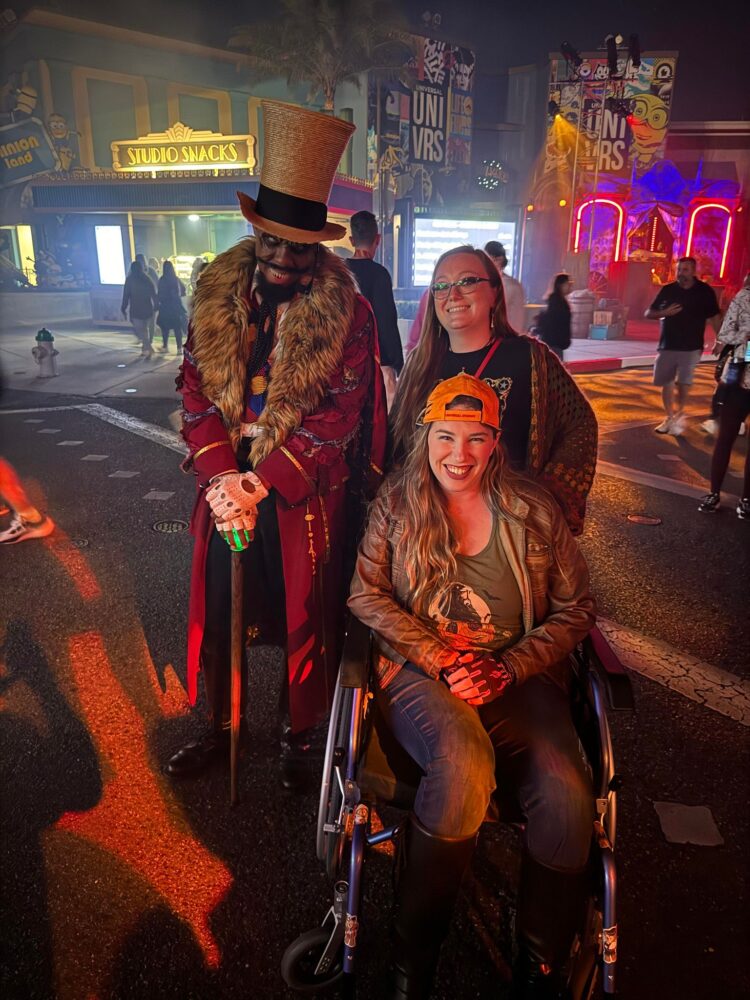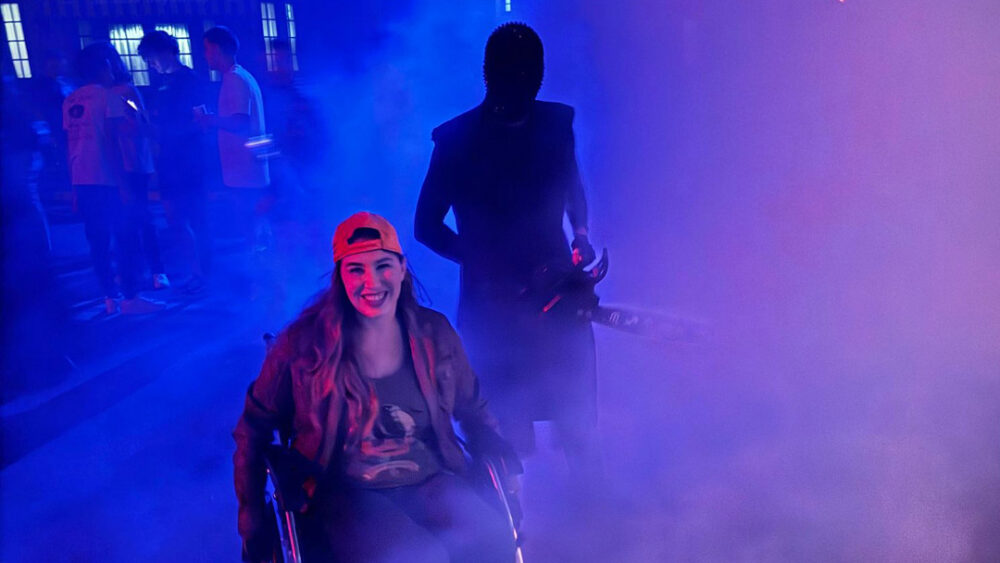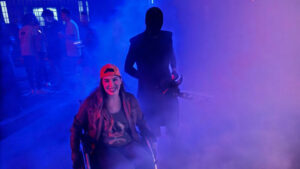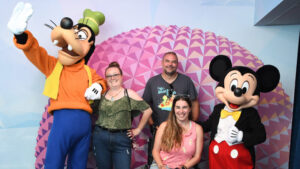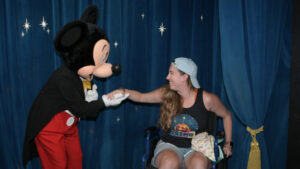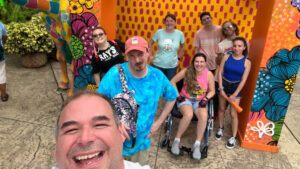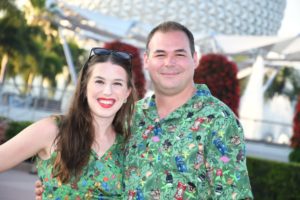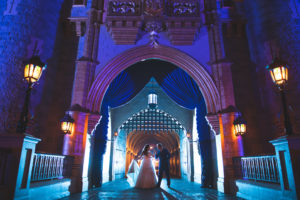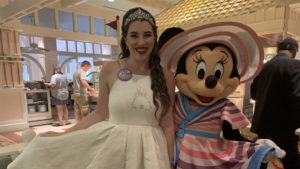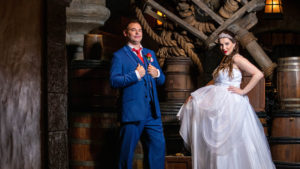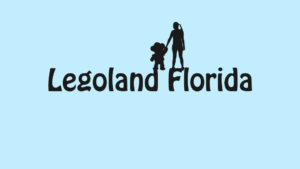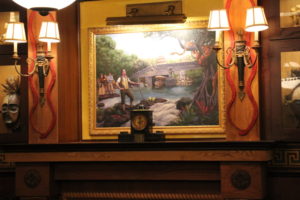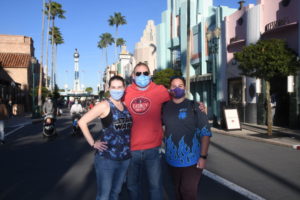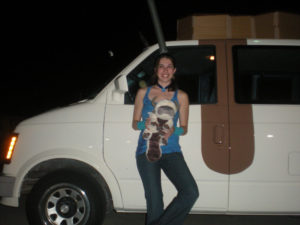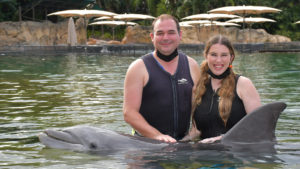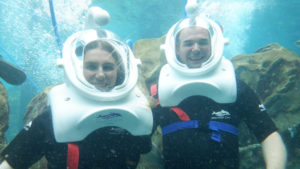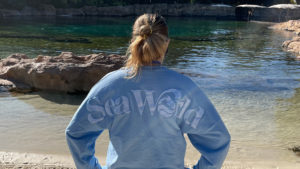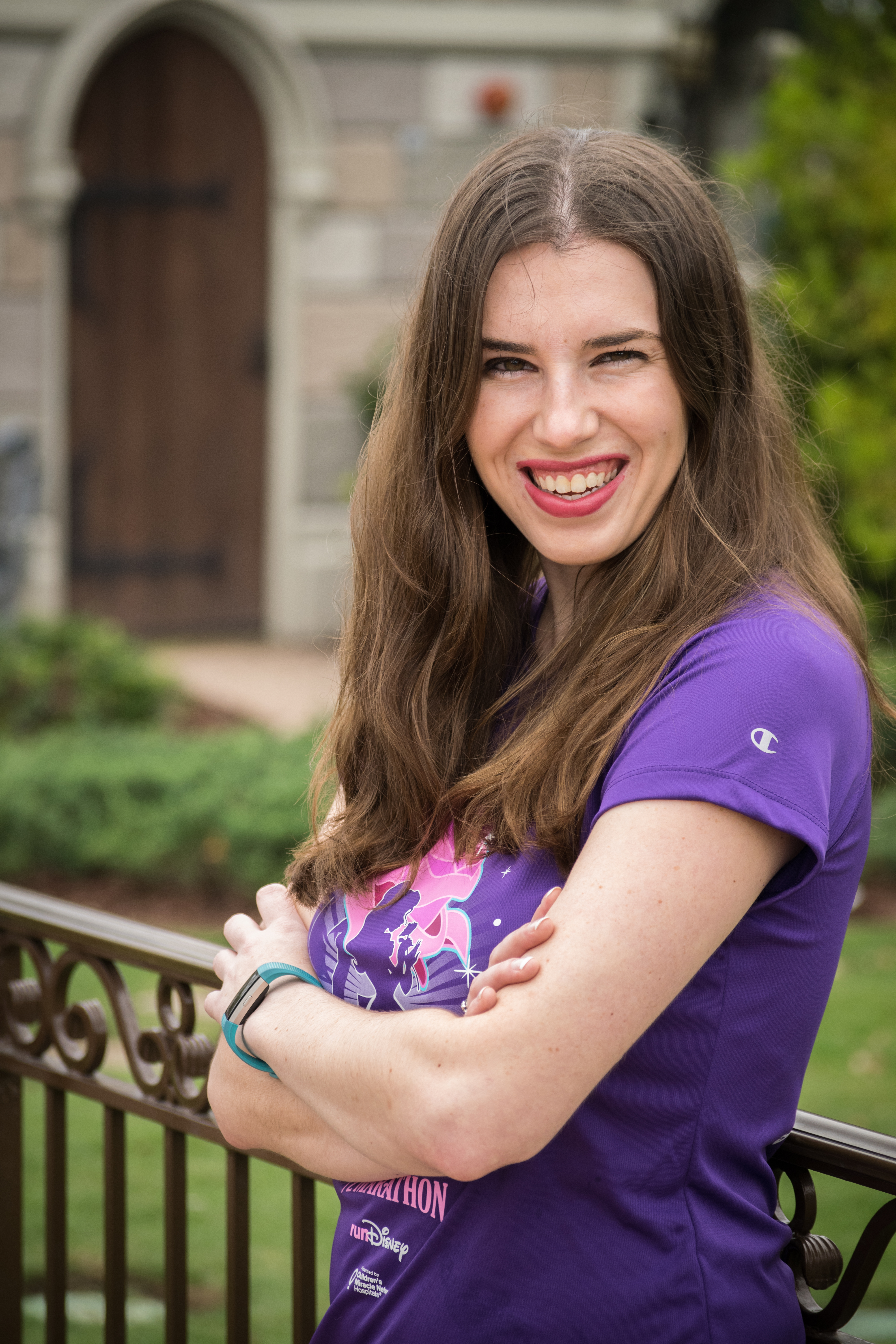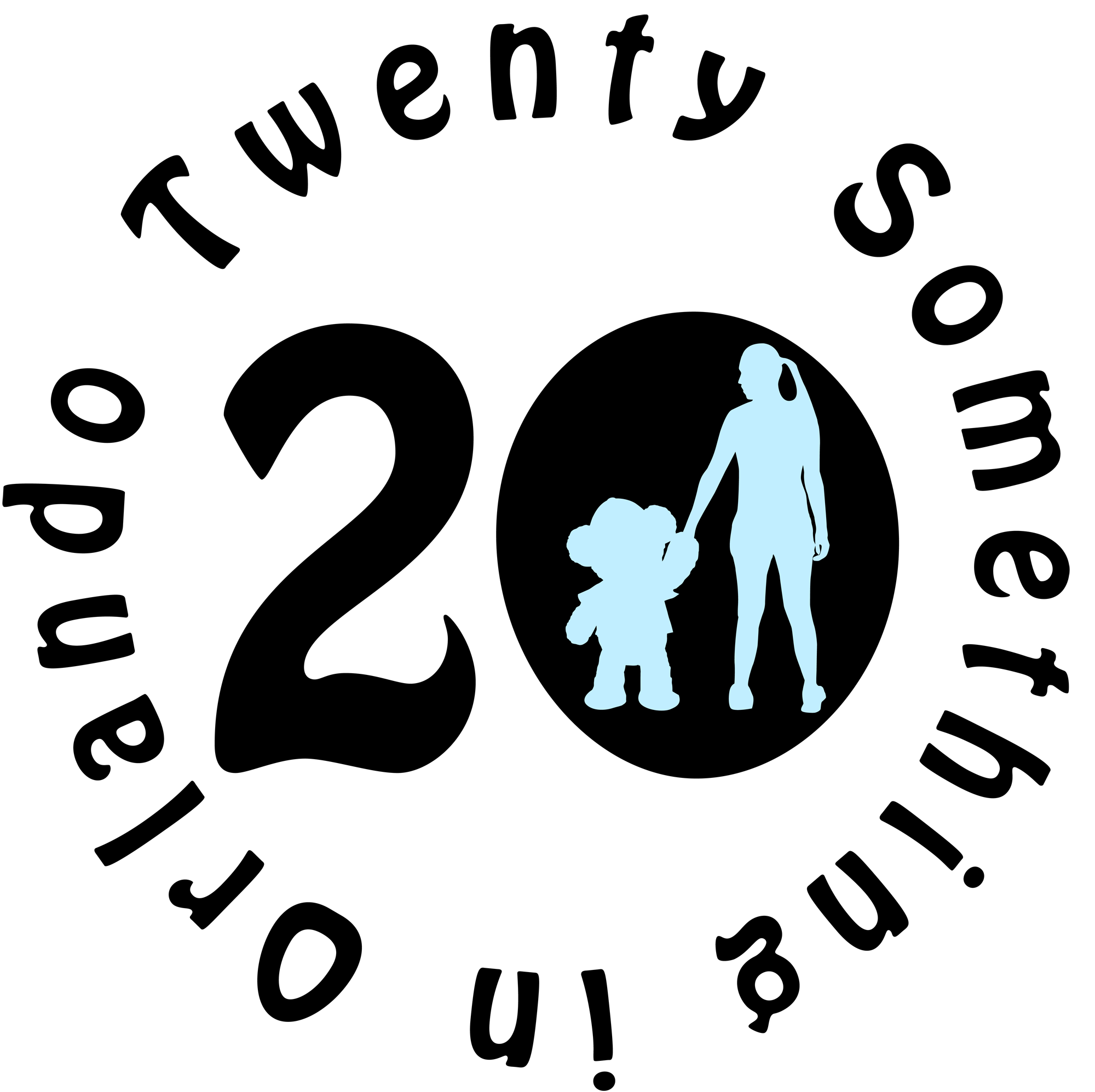Now you may be thinking, “Chelsea, Halloween Horror Nights ended on Saturday, why are you posting a guide now?” This isn’t a guide to Halloween Horror Nights 32 or 2023 or whatever you want to call it, this is a general guide on how to experience the event as a whole in a wheelchair. And I wanted a season’s worth of experience behind me to write it. I write reviews for things I’ve only done once; I write guides for things I’ve done enough to know what I’m talking about.
If you’re new here, hi, I’m Chelsea, ambulatory wheelchair user as of this year, and Orlando theme park expert. If you’re not new, you’re probably surprised I’m writing a Horror Nights guide, since the last one I wrote for the event was how to survive it if you hate it like I do.
I still don’t love Halloween Horror Nights, but I did get a Frequent Fear (season pass for the event) for the first time ever this year, so I could spend time with my friends and not worry about trying to accomplish all the things I wanted in a single night.
This is not an all-encompassing guide to Universal Studios Florida, although some of the stuff will cross over a bit; this guide is specifically going to talk about the challenges that come with this type of event. Universal Orlando as a whole is a place that I like to call ADA compliant, but not accessible. They do the bare minimum to meet the requirements of the law and not a thing more. And that’s their right. A lot of the problems I’m going to talk about would be easy to fix, but with the way they’ve changed their entire disability accommodation system this past year, I expect these parks to become less accessible, not more. They’re not interested in making it easier for us. And nothing I’m saying means you can’t go to Universal and have a fabulous time, but in my experience, the more you know with the wheelchair, the better you can plan.
This is a guide written in mind for people who have experienced the parks before but are now encountering the challenges of doing them in a chair. If you’re someone who uses a wheelchair full time, this guide may still be helpful to you, but if you’re using your chair day in and day out, I expect your knowledge to trump mine.
Halloween Horror Nights at Universal Studios Florida is considered to be the number one Halloween event in the country. The ten haunted houses have the same level of detail you’d find on a movie set, and they’re built more or less from scratch each year. Unlike Seaworld and Busch Gardens, you don’t see houses repeat year to year. Toss in five scare zones and a fantastic stage production, and you’ve got a recipe for an outstanding event that can be done in a wheelchair. It’s just easier if you know what you’re getting yourself into.
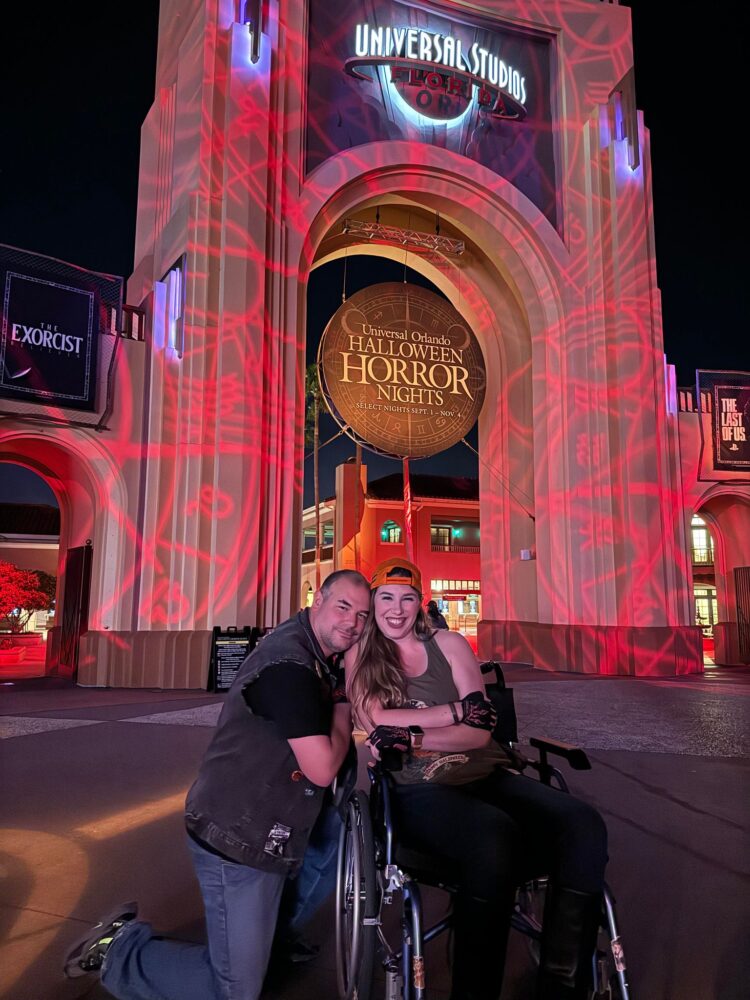
The Houses
Universal’s ten houses vary year to year, but they’re generally in the same spots, divided across the park. Five are usually housed in sound stages, while the other five are in tents put up just for the event. House construction begins months in advance. The event ended two days ago as I write this, and I promise you plans are already being made for next year.
The houses are wheelchair accessible, but guests in ECVs must transfer to standard wheelchairs. Courtesy wheelchairs are provided at the front of each house. I use my own wheelchair rather than an ECV, so I don’t have firsthand experience with that process. I also was asked at one house if I wanted to leave my chair outside, to which I responded, “it’s not optional,” and my response left that poor kid flustered. I had a Team Member at another house try to tell me I couldn’t bring my wheelchair in at all, and I had to tell him to get a supervisor before we were allowed in.
The houses are essentially tight mazes with lots of twists and turns to give performers places to hide. The paths snake through to maximize space and scare opportunities. This unfortunately means the pathways are super narrow. I did eight out of ten houses this year. Out of those eight, there was only one that had paths wide enough that I never got stuck, and I was capable of self-propelling (doing my wheels myself instead of having someone push me) all the way through. Every other house had a turn so sharp or so tight that I’d get stuck, and Jay would have to lift my back wheels to keep going. Most of the houses had slight changes in elevation or bumps that I would get stuck on. Two of the houses had such big bumps at the front door that I’d have to go backwards to get inside them. And one house was so dark and so tight that after getting stuck the fourth or fifth time and having a scareactor that wouldn’t let us pass, I decided I was never going in there again. For the rest of the event, Jay and my friends did that house without me.
If you’re an everyday wheelchair user with a better-quality chair, you may be able to get through the houses self-propelling. You’ve got experience and dexterity I lack in maneuvering a wheelchair, but for anyone doing this for the very first time, you’re probably going to need a friend to push you.
It’s also worth mentioning the Team Members in the house are instructed to keep everyone moving quickly to make the waits as short as possible. That means they’re going to be telling the person in front of the wheelchair to hurry up, even if they’re walking slowly on purpose to help with the big plastic curtains. And oh boy, do you need someone in front of you to push them aside in some of the houses.
Now I don’t expect the houses to be easy to get through, just because you’re trying to get a wheelchair through a dark, tight space. It makes sense that it’s a challenge. Haunted houses are not a concept that was invented with wheelchairs in mind. But Universal could make it easier. When they test the houses to make sure a wheelchair can fit in the pathways, they do it with the lights on and effects off. I couldn’t believe this particular piece of information when I heard it, but I was able to verify it from a friend of a friend on the design teams. And frankly having done these houses all year, yeah, they weren’t ever tested for wheelchairs in the dark. I’d be surprised if there was even a person in the test wheelchair, but I wasn’t able to get confirmation on that.
Again, the bare minimum they are required by the ADA. Wheelchairs technically fit. Who cares if they’re easy to push?
I own two wheelchairs. A Drive transport chair that I bought when I first got hurt, and a Medwarm chair my friend Pink gifted me. My Medwarm chair is far more comfortable, but it’s also wider. I probably could have had an easier time in the houses themselves with a narrower chair. Something to consider if you have multiple options. If you’ve got a wider chair, it might be worth renting a standard size, if you’ve only got one night to enjoy the event.
The Queues
The queues for the houses, particularly the houses in the tents, are the single biggest obstacle you will face. They utilize access roads made for cars, not people. While Jay can push my wheelchair through a drainage divot in the concrete, it’s not fun for either one of us.
These queues are put up and taken down every single day by team members who are only doing their job, which is to get it done as quickly as possible. So, as you’re going through these queues, you’re hitting the support structures for these bike rack fences every couple of feet. It hurts so freaking bad too.
I will give Universal credit here, we spent over half an hour at guest services waiting to complain about this particular issue, and it got better after that, but I also came armed with knowledge that my chair is 29” wide and that the ADA requires distances to be 36”.
They could fix this easily by drilling out holes for stantions like Magic Kingdom does for their parades instead of using this temporary fences.
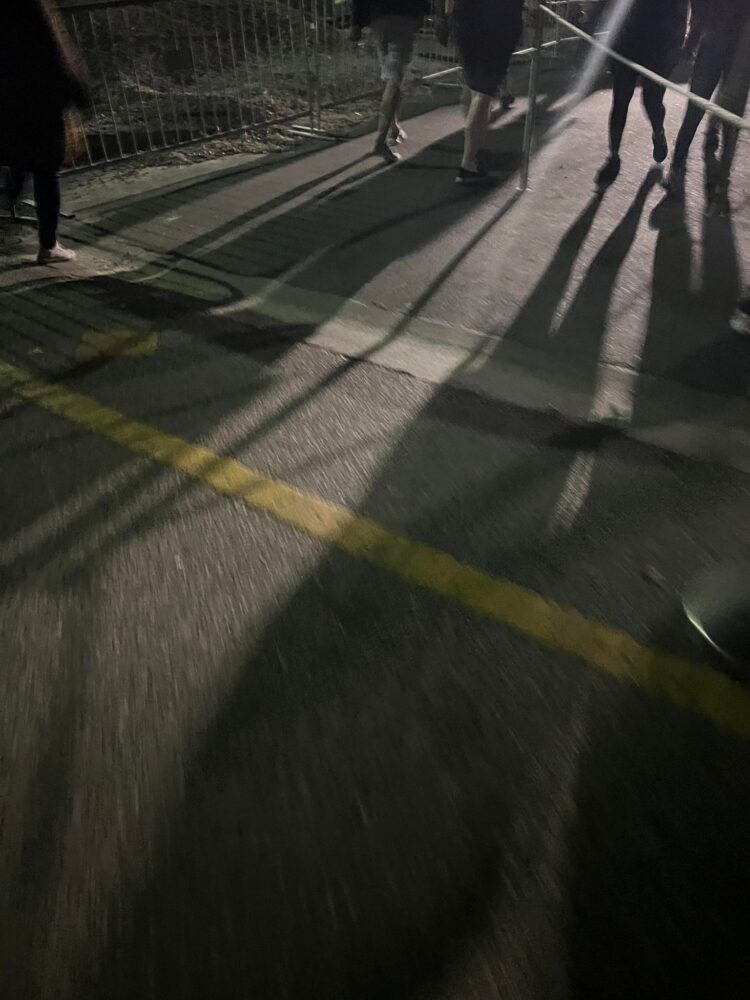
A divot that is not fun to take a chair through.
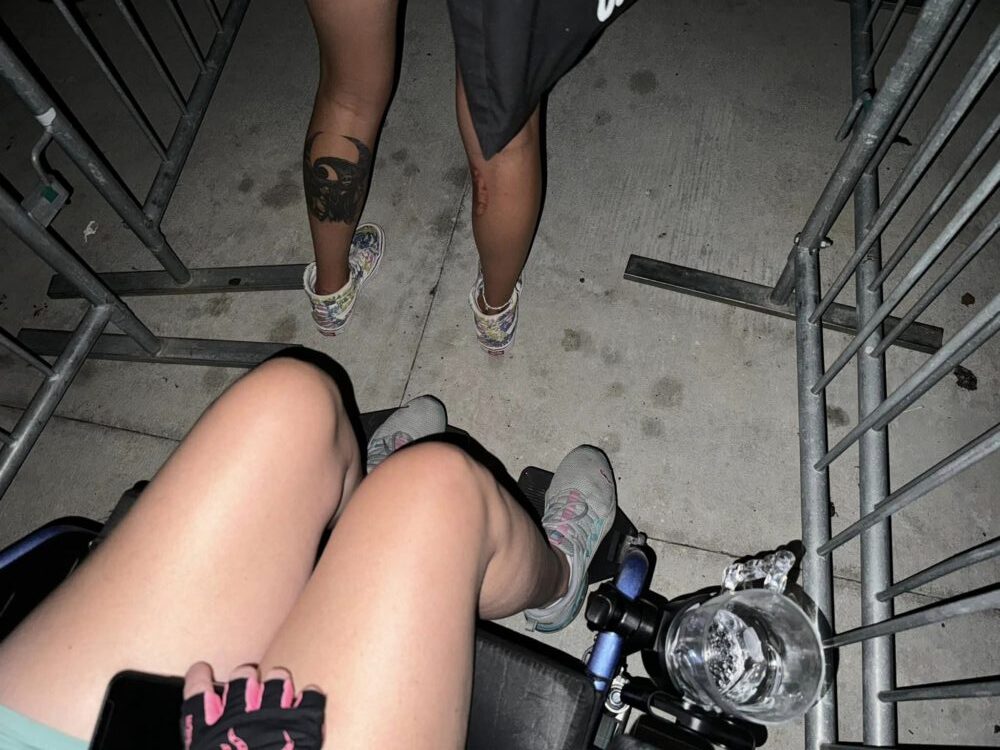
We’ll pretend that’s 36″.
The Scare Zones
Scare zones are exactly what they sound like. They’re open areas full of scareactors and some set pieces that you have to walk through to reach other areas of the park. They’re usually full of fog.
The fog is most people’s favorite thing about Halloween Horror Nights. There are two problems with it in a wheelchair. One, the machines are at the exact right height in the wheelchair where it hits you straight in the face for you to choke on. Two, depending on the night, the fog can be so thick that you can’t see where you’re going. There was a gentleman I collided with that to this day I don’t know if it was a guest or a performer, but I know he had bruises on his ankles and shins from the impact.
Another problem with the Scare Zones is that unlike the houses, the scareactors have complete freedom of movement. They get much closer to you. And for some reason, they really, really like to go for my face. This wouldn’t be a problem if I was walking, but having someone lunge for my eyes when I am not the person in control of my forward motion is a serious problem. It’s something coming for my face where I can’t stop. I can’t even duck back. And I don’t generally self-propel when we’re crossing the park, because it’s easier for someone pushing me to weave between guests and performers than it is for me, so when I say I can’t stop, I really can’t stop. The person pushing me can, but that’s only if their reflexes are fast enough to react when it’s not their face.
The only solution I’ve found for this particular problem is I prop my head on one arm and keep my hand up in front of my face in a defensive position. It looks like I might grab them, so they don’t come as close. I realize the point of going to Halloween Horror Nights is to get scared, but it’s in a “BOO!” way kind of way, not in a “I’m afraid you’re going to scratch my eyes and I’m going to have to go to the hospital” way.
You can also assume it’ll take you twice as long to cross a scare zone than if you were traveling on two feet instead of wheels. Between the performers and the guests stopping to watch the performers, it’s not fast. A particular problem area is San Fransisco in front of the exit for Fast and the Furious. There are decorative trolley tracks in the pavement that have popped the tires off my wheels more than once.
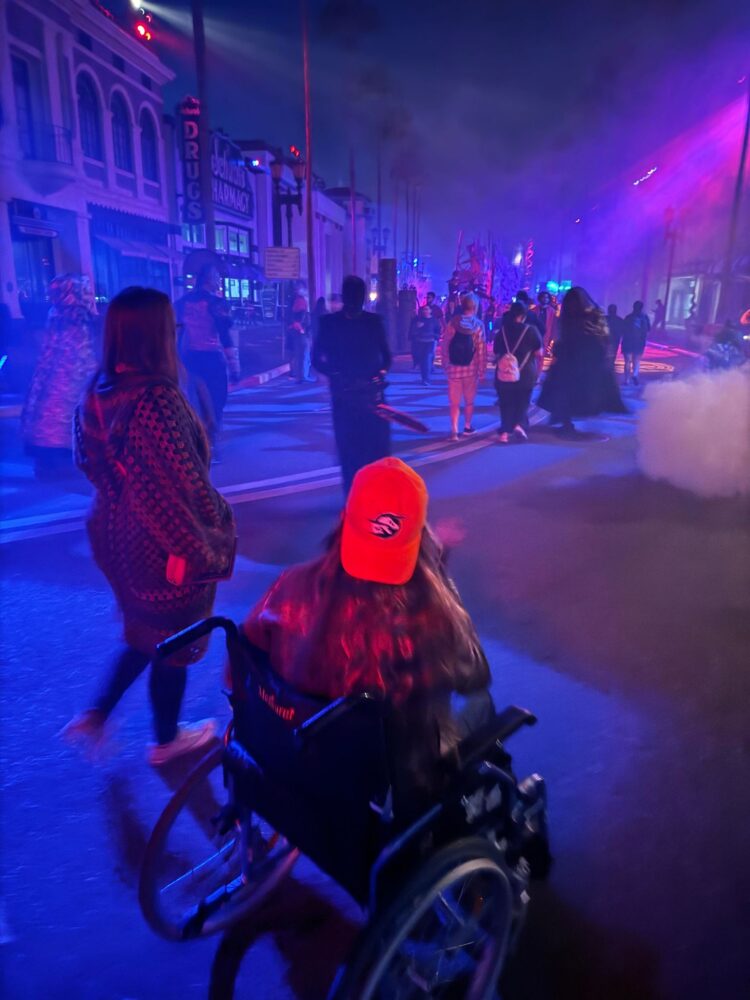
The Show
Since 2021, Halloween Horror Nights has been home to a show called Nightmare Fuel. It’s a fantastic production involving pyrotechnics, dancers, and aerialists. Most of these performers travel from the UK to perform here every year. It’s one of the most popular things at Halloween Horror Nights and my personal favorite.
There is a designated entrance for guests with disabilities, but there’s a flaw. Anyone with a disability pass can use this line, along with anyone who says they can’t do stairs. While I don’t want these people pushed into the regular line, it’s upsetting when a group of seven people with no wheelchair in sight take the front row. Some nights the show is well staffed and those without wheelchairs are directed to the second and third rows of seats, so they’re doing minimal stairs but they’re not hogging the only seating wheelchair users can use on the ground level.
While I am ambulatory and can get out of my chair, I can’t navigate the throng of people leaving to reach my chair, so it’s better for me to stay in. If it’s just me and Jay, he sits in the front beside me or behind me. If we’ve got a larger party, we usually have two with me in the front and everyone else takes the row behind us.
But on nights when they’re short of employees, it’s a free for all. I’ve seen people without wheelchairs take the seating reserved for RIP tour guests with wheelchairs. I’ve seen groups that had no chair at all hog three rows worth of seats. And the worst was someone in a chair in a zone that no one’s supposed to be in, but they didn’t know. By the time the employees caught on, there was nowhere for them to go and they were in the process of being kicked out when my group smushed up, and Jay sat behind me to make room for them. The woman pushing the chair thanked us with tears in her eyes.
Towards the beginning of the Halloween season, they parked each party one by one and made sure the wheelchair spaces were taken by actual wheelchair guests, letting the others that need accommodation take the second, third, and even fourth rows. But the later into October it got, the less staffing they had, and the more stressful it was.
The disability entrance for Nightmare Fuel, or whatever show it is going forward, is off to the right, away from the other lines. You want to be there thirty to forty minutes before showtime if you need to stay in your chair and want to have hope of being closer to the center than the sides.
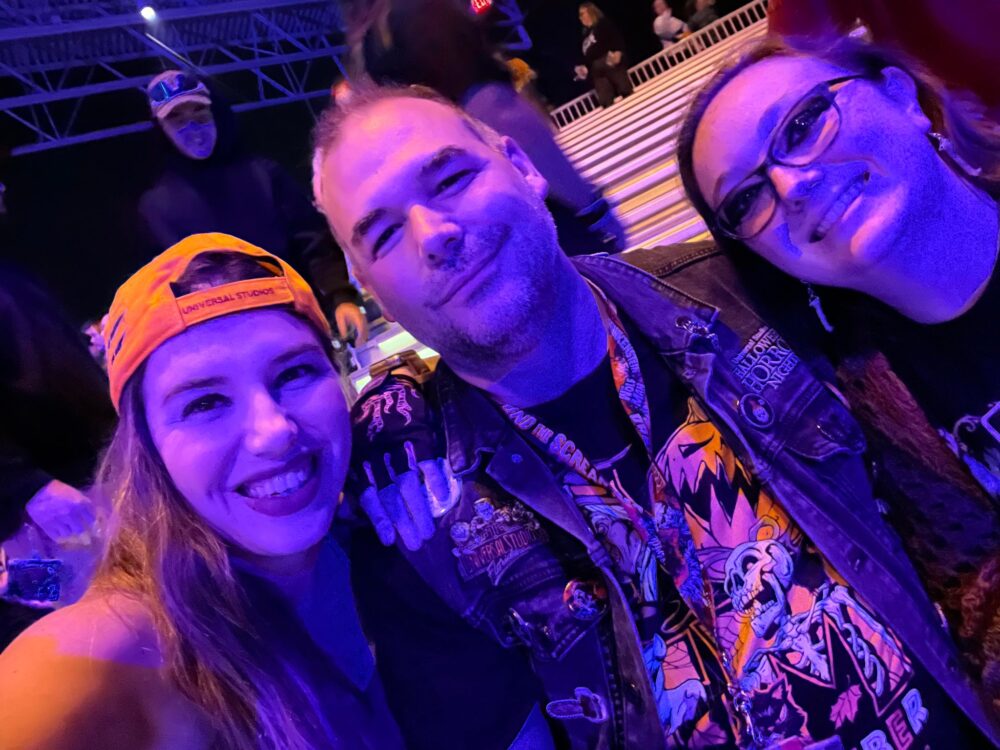
I realize it’s hard to see, but I’m in my chair and Jay and Morgan are squished up next to me.
So, as I said, Halloween Horror Nights is a great event if you’re someone like my husband. It’s a good way to spend time with your friends if you’re like me. There’s nothing about this event that makes it impossible to do it in a wheelchair. In fact, there are some things that can be better. Scareactors like to zoom in on the wheelchair for whatever reason. You get more time in the houses, because you can’t rush. You get front row seating for the show. But doing HHN in a wheelchair comes with some unique challenges, and I wouldn’t be launching a good series of wheelchair guides if I didn’t help you prepare for them.
